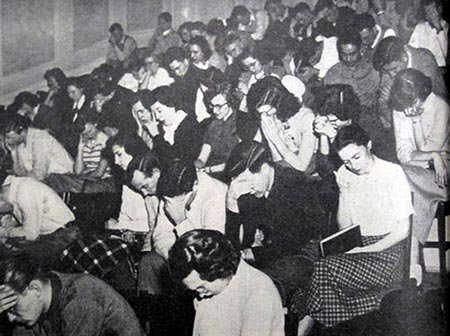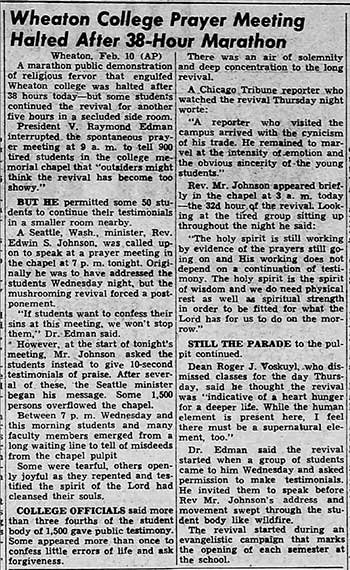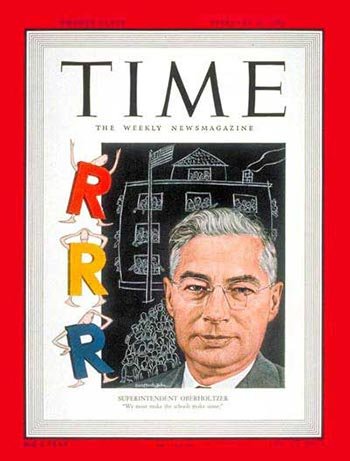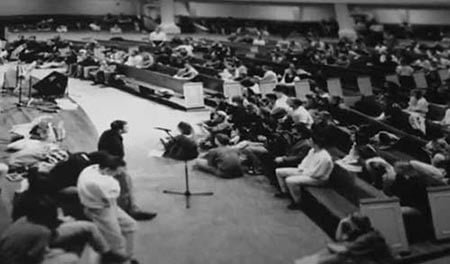Snapshots of Revival at Wheaton College – 1970
Spring 2015 Wheaton Magazine

Wheaton College Revival
The Essence of Revival
Twenty years after Wheaton’s 1995 revival, glimpse the spiritual climate on campus, and view snapshots of the work God has done through these times of spiritual cleansing and renewal.
by Rich McLaughlin
“The second this young man sat down, the brothers who were standing next to me all immediately started climbing over people and pews to reach this broken man. Once they did, they embraced him, cried with him, expressed forgiveness, and prayed for him.”
“The 1970 revival decisively and wonderfully transformed the general atmosphere on campus for the remainder of my time there . . . I can never look at anyone, myself or others, and conclude that that person is beyond the reach of God’s grace.”
“God is stirring a passion for prayer on this campus,” Student Government chaplain Katrina Burlet ’15 wrote in a #MyWheaton blog post this February. “Students are gathering for prayer meetings every Tuesday during chapel time, and are forming organic prayer groups in residence halls and in on- and off- campus housing.”
Since Interim Chaplain Rev. Dr. Dave McDowell ’68 arrived on campus in September, he’s seen “a widespread desire for prayer—prayer for global social justice issues, prayer for deeper reconciliation and spiritual growth on campus, and very specific prayer for revival,” he says.
This March marked 20 years since Chaplain Emeritus Dr. Stephen Kellough ’70 sent a memo to all faculty and staff at the close of a remarkable week of revival on campus. In his memo, he described the events of the week as “a movement of God’s spirit,” “an outpouring of His love,” “a time of spiritual awakening,” “a special visitation from God,” “a significant stirring of the Spirit,” and “a divine initiative.”
The variety of his descriptions for these fresh works of the Holy Spirit help us round out an understanding of such events in history, just as the many names used for God in the Bible help us begin to grasp who He is.
Chaplain McDowell defines revival as “a special and sovereign work of God where He visits His people to reanimate, to restore, and to release in them the fullness of the Holy Spirit for the furtherance of the gospel in the world.” He notes five characteristics common in times of revival:
• A time of preparation;
• often evident times of crisis or spiritual apathy;
• acute awareness of God’s majesty and holiness and of the depth of human sin;
• confession of sin with a knowledge and certainty of forgiveness; and
• the growth of the church and its mission in the world.
In the wider backdrop of Wheaton’s history, W. Wyeth Willard wrote that Jonathan Blanchard “believed that God had need of Wheaton College to aid the way for His coming.” Since those early years, the many accounts of visitations of God’s presence seem to warrant a closer look. After all, when God’s Spirit visits his people, each occasion is important. When God repeatedly visits nations and places, these accounts are all the more intriguing.
While there may have been as many as 10 Wheaton College revivals before 1900, the following vignettes provide a closer look at the ways that the revivals of 1936, 1943, 1950, 1970, and 1995 have contributed to the work God is doing at Wheaton and worldwide.
1936: From Revival to the Urbana Missionary Conference

Wheaton College Revival Newspaper report 1950
Dr. H. Wilburt Norton ’36 says the results of the 1936 Revival are as significant as the event itself. The special speaker during campus’ mid-winter Evangelistic Services in February was Dr. Robert C. McQuilkin of Columbia Bible College. He started the week of messages Wednesday, but became ill. On Thursday morning, Dr. Walter Wilson of Kansas City Bible College shared, then opened up for questions.
“At least one student stood up right away and asked for prayer,” Dr. Norton explained. “One after another, they stood up. There were so many standing up . . . the whole chapel service turned into a testimony time with students asking for prayer because they were convicted of sin, and felt a need to pray.
They lined up against the walls and took turns in an organized way asking for prayer. Students were weeping . . . They were freely and spontaneously asking for prayer as they wept and cried over their sin. That service did not terminate until 10 p.m. that night.”
When Dr. McQuilkin recovered and returned to conclude the week of services, he asked all the students who were preparing for missionary service to stand. Then, he asked those who had not yet decided on a career, but would be willing to go to the mission field, should the Lord so lead, if they would stand and join those already standing.
“I felt constrained to stand,” Dr. Norton said. “Dr. McQuilkin was encouraging students to get together and begin to pray for missions. To make a long story short, out of that broken-up, student special service activity, and the revival . . . came the Student Foreign Missions Fellowship (SFMF).”
Relationships forged during that week in 1936 among Wheaton College students, and later with Columbia Bible College students, and many other missions-minded students created SFMF. In time, SFMF merged with Intervarsity Christian Fellowship, led by another Wheaton graduate, Dr. C. Stacey Woods ’34, who became the first director of the Urbana Missionary Conference.
In retrospect, Dr. Norton connects the dots between the missionary mobilization and the earlier providential stirrings of the Spirit in 1936.
“That (Urbana) conference grew every three years until 20,000 students met every three years to discuss and pray for missions,” Dr. Norton says. “Therefore, what happened in February 1936 was God’s preparation for what was going to happen in the post-war era. GI’s came to Jesus Christ . . . and volunteered to go overseas, because they had been there. They’d seen the church. They’d seen the need. They wanted to do something.”
1943: Convicted to Confess
From the 1943 Wheaton College Revival, Samuel D. Faircloth ’43 provides a wonderful window through which to see those events:
“The thing that was the most impressive for me was when several of us, including Billy Graham ’43, LITT.D. ’56, were praying for a whole year on Friday nights in each other’s rooms for revival on campus. We were praying that God would bring conviction to correct a number of sinful things going on. “President Victor Raymond Edman HON knew we were praying, but he was the only person who knew it. We weren’t trying to make any fanfare about anything. We were praying for God to act in those revival prayer meetings composed of a half a dozen serious students, crammed into those small dorm rooms. Billy was always on the floor, flat on the floor. He was pounding on the floor, and I remember him saying, ‘All I want to do, Lord, is win souls.’And we all know now how the Lord took him up on that request!
“We prayed, and all of a sudden, you know what happened?” he asks. He then explains that the captain of the track team went to the podium during the Monday morning chapel service, after the Chicago Tribune had printed a story about the Wheaton College track team winning a meet that previous Sunday. The College hadn’t given permission to be there on Sunday, and “the track captain was convicted that he had sinned against the school.” This confession was the first in what was to be an avalanche of confessions.
“It didn’t stop for two to three days . . . faculty members, students, everybody lined up behind the microphones for their turn to speak,” Faircloth says. “And it came to the point where people didn’t even go to eat. Certainly, God had answered our prayers!”

Time Magazine 20th Feb. 1950
1950: To Time Magazine and beyond
The 1950 Revival received national news coverage with aTimemagazine article titled “42 Hours of Repentance,” published February 20, 1950. (see here) Plenty of interviews were conducted on campus with students apart from the mainstream media, including a BGC Archives interview with the late Betty Burtness Knoedler ’50.
When asked if the confession of sin was a big part of it, Knoedler answered, “Yes, and I believe one of the key moments of the revival experience was when Dr. Clarence Hale ’28, one of the most respected, and godly, professors on campus, got up in front of the entire student body and confessed sins in his life. I think we all thought, If Dr. Hale thinks that way, where do I fit into this whole picture?
“The classes of ’49 and ’50 were blessed with great leadership. Our class officers included Bud Schaeffer ’50 and Dick Reed ’50, along with others, many of whom had served in the military, who were four or five years older than most of us, who had experienced the horrors of war, and who brought a dimension of maturity and spiritual seriousness to campus.
“Many of these men and women, like Nate Saint ’50, Ed McCully ’49 and Dave Howard ’49, went on into very significant and productive full-time ministry. These classmates were not the only spiritual people on campus. However, they were the ones who expressed their beliefs publicly, and with confidence. As I look back, I believe God was preparing the Wheaton campus for a special time of spiritual renewal through the lives and experiences of these special godly young men and women.”
Likewise, David Howard ’49 confirms this dynamic during those years on campus, and provides further perspective on the revival that came:
It can be said that the seeds for the revival of 1950 were being planted on Wheaton’s campus in 1949. We had a great class led by a lot of godly men and women, who were used by God to help lay a foundation. None of us ever conceived that a revival of the depth and breadth of 1950 would happen, and we 49ers cannot claim to have been responsible. But in hindsight we can see how God was preparing the campus for a great work of the Holy Spirit to happen the following year. I recall Jim Elliot once raising the question – partly in fun and partly seriously—“‘Did God have to get rid of the 49ers before He could do a great work among the students in 1950?’”
Dean Borgman ’50 was working at the Stupe when the revival began and went to the meeting when no one was coming to order any food. While Dean quickly shares that he was not among the spiritual leaders on campus, God used the 1950 revival powerfully in his heart.
“I was very open and desirous, but still I think a rebellious sort inside, so for me, the revival, as it hit me that first night, was very, very powerful in time,” Borgman says. Looking back, he notes, “I think God was breaking my rebellious streak.” He remembers seeing “marvelous things happening,” wandering campus, throwing himself down on a wrestling mat, and “praying with loud cries to the Lord for supernatural power to follow Christ and the Holy Spirit completely.” When he got up from the mat, he notes, “I was just a regular Christian guy who had to go back to living my life the best I could.”
In the years that followed, Borgman went on to become Gordon-Conwell’s Chair of Youth Ministries, and in 2014 received a Youth Specialties Lifetime Achievement Award. Borgman’s testimony makes one wonder how many more stories of life impact are yet to be heard, as God was simultaneously working in unseen places.
1970: Cynicism Altered
A student at the time, John H. Armstrong ’71, M.A. ’73 remembers what happened during four days of meetings with Ray Ortlund, Sr.
“After four days, there was little evidence of the Spirit doing anything corporately. Suddenly, on Thursday evening, a student asked President Hudson T. Armerding ’41 if he could share his story,” he says. Others unexpectedly came to speak, and “within less than an hour, many wanted to speak. Conversions began to happen, and people poured into the chapel.” Thanks to a live broadcast on WETN, “many began to come from their dorms and from the city. A large crowd had gathered by 10 p.m., and the meeting went on through the night.
“The entire weekend, a spirit of joy and transformation pervaded the campus. Cynicism was altered. Churches were touched,” he says. “Dr. Armerding asked me to speak in a number of places, and I found high school students receptive and churches listening with joy. I spoke at Trinity Evangelical Divinity School and other schools as well. The fame of what God did at Wheaton lit a flame elsewhere, far beyond the College community.”
The son of the guest speaker, Dr. Raymond C. Ortlund Jr. ’71, notes that the revival still impacts his life today.
“The Holy Spirit, I believe, gave us the courage to make wrong things right and get a fresh start together,” he said. “The 1970 revival decisively and wonderfully transformed the general atmosphere on campus for the remainder of my time there . . . I can never look at anyone, myself or others, and conclude that that person is beyond the reach of God’s grace. With Jonathan Edwards, I believe that revival is God’s standard strategy for advancing his cause with dramatic acceleration. To have witnessed it personally is thrilling—I want to see the Lord do that again!”
1995: Prayerful Preparation

Wheaton College Revival
According to Dr. Tim Beougher, former assistant professor of evangelism and Associate Director of the Institute of Evangelism at the Billy Graham Center, students came to Wheaton College in 1994 in hopes that God was going to do a work on campus.
“During the fall of 1994, three different freshman students come by my office saying, ‘I understand that you have an interest in revival,’” Dr. Beougher says. “They didn’t know one another, but as each was praying, God had laid on their hearts that He was going to do a work here.”
Prayer and praise were clearly interwoven before, during, and after the 1995 revival. Todd Wilson ’98, M.A. ’01, recalls the Sunday evening World Christian Fellowship meeting that catalyzed four days of campus confessions.
“I vividly remember the moment at which the Spirit fell upon the gathering of students. Student leaders from Howard Payne shared. It was then open for Wheaton students to share and, if need be, confess.
“A few did, as I remember, and then a fifth-year senior, a well-known and well-liked guy on campus, went to the microphone and confessed bitterness and things of that sort. It was powerful. This was followed by a student confession of sexual sin. Then one of the leaders asked if anyone else who struggled with that wanted to come up to the front for prayer. All of a sudden, dozens and dozens of students got up and went forward, and the atmosphere of the place suddenly transformed. The Spirit of conviction and cleansing had fallen upon us.”
A graduate school student in spring 1995, Holly Bell M.A. ’95, expressed God’s tangible nearness during the prayer meetings.
“It was just so strong and so thick, like the Spirit was so thick, I never, ever experienced anything like that in my whole life,” she says.
Prayer and confession continued throughout the week, pouring out into College Church sanctuary on March 21st. Randy Gruendyke ’82, who was serving as the college pastor at College Church at the time, described what was happening as “the lancing of a spiritual boil—needed, messy, and painful. But the results were nothing short of healing, transformative, and life-giving.”
Erik Thoennes M.A. ’94, M.A. ’95 remembers one particular example of forgiveness and reconciliation. “ young man confessed racist attitudes, especially toward the Asian students on campus. With tears, he confessed that he had denigrated especially Asian students during his time at Wheaton. He earnestly asked for forgiveness. I was standing in the back of Pierce Chapel with several Korean students who I knew from playing basketball with them. They were also part of the Korean fellowship group on campus. They listened to the confession with intense seriousness. When the student finished, he broke down in tears, and sat down in the front row—face in his hands.
By this time the aisles had become filled with students praying for themselves and each other, some of them prostrate—others weeping and laying hands on one another and praying for the power of the gospel to more deeply invade hearts. The second this young man sat down, the brothers who were standing next to me all immediately started climbing over people and pews to reach this broken man. Once they did, they embraced him, cried with him, expressed forgiveness, and prayed for him. It was a powerful display of the reconciling power of the gospel.”
On the fourth night, President Emeritus Duane Litfin drew upon Isaiah 6 as a fitting way to frame what was happening. “Isaiah said, ‘I saw the Lord. High and lifted up . . .’ and as a result he said, ‘I am a man of unclean lips’ and he confessed his sinfulness. And when our sinfulness is an expression of our response from seeing the Lord for who and what he is, it’s good and healthy,” Litfin said.
That last night’s time of praise was highlighted in many interviews. Among others, Nathan Oates ’95, M.A. ’98 warmly remembered a heightened sense of God’s presence:
“I was especially blessed by the presence of God and felt an unusual sense of joy in worship,” Nathan says. “I have never felt that kind of presence of God before. I was overwhelmed to the point of laughing and crying at the same time in the presence of the Lord as we worshipped him that Thursday night.”
Regarding corporate praise and worship that week, the worship leader Nathanael Fawcett ’96 considered one song, “We Will Dance,” to serve as an anthem.
“It’s very celebratory,” Nathanael says. “The chorus goes, ‘We will dance on the streets that are golden, the glorious bride and the great Son of Man. From every tongue and tribe and nation, will join in the song of the Lamb.’”
Students at Wheaton received many requests to share what had happened during that week of revival in 1995. Leo Sumule M.A. ’96 had an opportunity to share his testimony at Trinity International University in Deerfield, Illinois, and Claudia Micaela Lopez ’97 went with teams to two other Midwest schools, where she was struck by how God responds to the prayers of his people, according to their needs in each particular place.
“I think God meets the cries of his people,” Lopez said. “Every group is so different, yet He knows what’s best, and He’s doing what needs to happen.”
This article is reproduced here with the kind permission of the author, Rich McLaughlin, Trinity International University, Trinity College, Adjunct, and the original publishers, Wheaton Magazine, Spring 2015, Wheaton College (IL).



